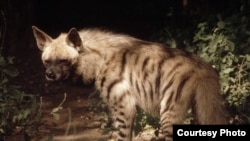Conservationists were stunned in mid-2006 when a striped hyena (Hyaena hyaena) was spotted on eastern Turkmenistan's Amudarya nature reserve, which borders Uzbekistan. Since then, hyena tracks have appeared and howls have been heard elsewhere on the reserve.
Olga Pereladova, the director of the conservation group WWF's Central Asia Program in Moscow, tells RFE/RL that this is good news for the nomadic hyena, which appears to have extended its habitat northward. She says it also suggests that Turkmenistan's damaged environment is on the mend.
"Usually [the hyena] eats carcasses of dead animals. It can come only to areas where there is enough food," Pereladova says. "So it's good news for us -- people dealing with ecosystems conservation -- because it is an indication that the ecosystem is in good shape, that different species are increasing, that the population number of prey species is high enough and there is enough food for predators."
Tough Environment
Its habitat spans from Morocco, in the west, as far east as India. But habitat has been lost to agriculture, and Central Asia has been no exception.
In the early 1990s, economic hardship prompted locals to hunt wild animals for food, and many hyenas were killed to prevent attacks on livestock.
The striped hyena scavenges carrion -- often leftovers from predators like wolves or leopards. Food sources -- like the Bukhara deer -- have declined.
From Dushanbe, zoologist Farhod Davlatov tells RFE/RL that's what happened in southwestern Tajikistan.
"The Vakhsh Valley was plowed and irrigated in the 1930s, cotton was produced, and people were moved from mountain regions," Davlatov says. "Humans limited the animals' living space. There were many yaks and deer, but they gradually disappeared. So there was less food for hyenas, and they slowly disappeared, too."
Few Hyenas Left
In Central Asia, striped hyenas are found mostly in southern Turkmenistan, but only in small numbers. Few of the animals have been recorded in southern Uzbekistan or Tajikistan in recent years.
The WWF's Pereladova estimates that fewer than 200 hyenas are left in the region, including the northern border regions of Afghanistan and Iran.
She says the sighting of a hyena in northeastern Turkmenistan shows that efforts to restore ecosystems in the region can succeed.
"[Now] people know that the ecosystems are their treasure, so there are fewer violations of conservation legislation," Pereladova says. "And all animals feel better and populations are increasing."
Pereladova cites a seven-year-old WWF project to save Bukhara deer in Central Asia, in which environmentalists are working closely with local communities.
(Firuz Barotov of RFE/RL's Tajik Service contributed to this report.)














